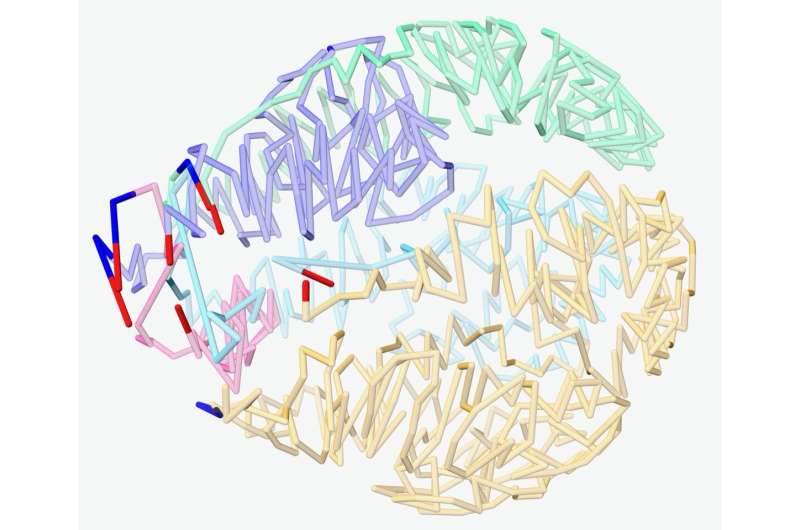This article has been reviewed according to Science X's editorial process and policies. Editors have highlighted the following attributes while ensuring the content's credibility:
fact-checked
peer-reviewed publication
trusted source
proofread
Researchers warn of tick-borne disease babesiosis

"Tis the season for hiking now that spring has arrived and temperatures are on the upswing. But with hikes come insect bites and on the increase in North America is babesiosis, a malaria-like disease spread especially between May and October by a tick.
Indeed, recent research suggests an increase in the incidence of diseases transmitted by ticks around the world, not just the United States and Canada, due likely to climate change and other environmental factors. Among the tick-borne pathogens, Babesia parasites, which infect and destroy red blood cells, are considered a serious threat to humans and animals. All cases of human babesiosis reported in the United States have been linked to either Babesia microti, B. duncani, or a B. divergens-like species.
Now a research team led by scientists at the University of California, Riverside, and Yale University reports the first high-quality nuclear genome sequence and assembly of the pathogen B. duncani. The team also determined the 3D genome structure of this pathogen that resembles Plasmodium falciparum, the malaria-causing parasite.
"Our data analysis revealed that the parasite has evolved new classes of multigene families, allowing the parasite to avoid the host immune response," said Karine Le Roch, a professor of molecular, cell and systems biology at UC Riverside, who co-led the study with Choukri Ben Mamoun, a professor of medicine at Yale University.
According to Le Roch, who directs the UCR Center for Infectious Disease Vector Research, the study, published today (April 13) in Nature Microbiology, not only identifies the molecular mechanism most likely leading to the parasite's pathogenicity and virulence, but also provides leads for the development of more effective therapies. The research paper is titled "Babesia duncani multi-omics identifies virulence factors and drug targets."
"By mining the genome and developing in vitro drug efficacy studies, we identified excellent inhibitors of the development of this parasite—a pipeline of small molecules, such as pyrimethamine, that could be developed as effective therapies for treating and better managing human babesiosis," Le Roch said. "Far more scientific and medical attention has been paid to B. microti. The genome structure of B. duncani, a neglected species until now, will provide scientists with important insights into the biology, evolution, and drug susceptibility of the pathogen."
Human babesiosis caused by Babesia duncani is an emerging infectious disease in the U.S. and is often undetected because healthy individuals do not usually show symptoms. It has, however, been associated with high parasite burden, severe pathology, and death in multiple cases. Despite the highly virulent properties of B. duncani, little was known about its biology, evolution, and mechanism of virulence, and recommended treatments for human babesiosis against B. duncani are largely ineffective.
A strong immune system is required to fight the pathogen. A compromised immune system could lead to flu-like illness. The tick that spreads babesiosis is mostly found in wooded or grassy areas and is the same tick that transmits bacteria responsible for Lyme disease. As a result, about 20% of patients with babesiosis are co-infected with Lyme disease.
B. duncani mostly infects deer, which serve as the reservoir host during the pathogen's asexual development. The parasite's sexual cycle occurs in the tick after the tick bites the infected deer. When this tick bites humans, infection begins. The full life cycle of Babesia parasites has not yet been determined. The tick that spreads babesiosis, called Dermacentor albipictus, lives longer than mosquitoes and could facilitate a long life cycle for B. duncani.
Even though scientists are discovering more Babesia species, diagnostics are mostly developed for B. microti. Le Roch is already working with Stefano Lonardi, a professor of computer science and engineering at UCR and co-first author of the study, on new Babesia strains that have evolved.
"The Babesia genomes are not very long," said Lonardi, who assembled the B. duncani strain. "But they are challenging to assemble due to their highly repetitive content and can require years of research. Once the genome is assembled and annotated, it can provide valuable information, such as how the genes are organized, which genes are transcribed during infection, and how the pathogen avoids the host's immune system."
In older and immunocompromised people, if B. duncani is left unattended, babesiosis could worsen and lead to death. Once the pathogen enters the body and red blood cells start to get destroyed, fever, headache, and nausea can follow. People who get bitten by the ticks often don't feel the bite, which complicates diagnosis. Skin manifestations of babesiosis are rare, Lonardi said, and difficult to separate from Lyme disease.
Le Roch and Lonardi urge people to be mindful of ticks when they go hiking.
"Check yourself for tick bites," Le Roch said. "When you see your physician don't forget to let them know you go hiking. Most physicians are aware of Lyme disease but not of babesiosis."
Next the team plans to study how B. duncani survives in the tick and find novel vector control strategies to kill the parasite in the tick.
Le Roch, Mamoun, and Lonardi were joined in the study by colleagues at UCR, Yale School of Medicine, Université de Montpellier (France), Instituto de Salud Carlos III (Spain), Universidad Nacional Autónoma de México, and University of Pennsylvania. Pallavi Singh at Yale and Lonardi contributed equally to the study. The B. duncani genome, epigenome, and transcriptome were sequenced at UCR and Yale.
More information: Stefano Lonardi, Babesia duncani multi-omics identifies virulence factors and drug targets, Nature Microbiology (2023). DOI: 10.1038/s41564-023-01360-8. www.nature.com/articles/s41564-023-01360-8
Journal information: Nature Microbiology
Provided by University of California - Riverside



















